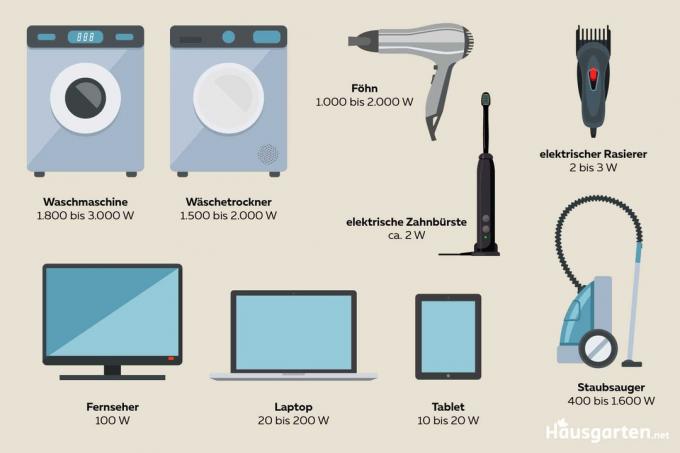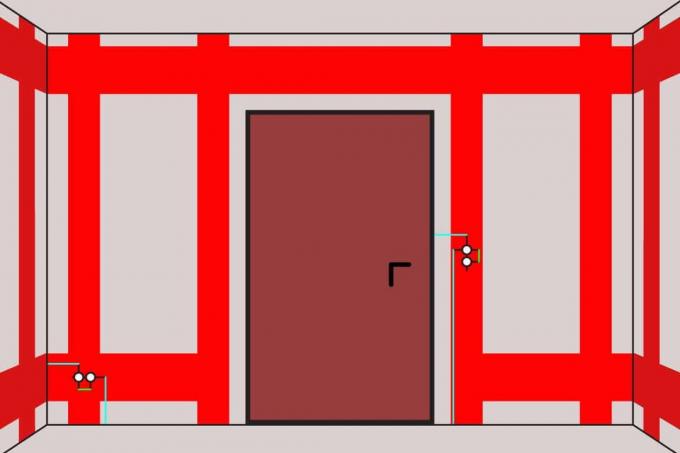

Table of contents
- units
- resilience
- consumption
- sockets per fuse
- sample numbers
- Information for orientation
- Caution: risk of tripping
- Orientation to power consumption
At the latest when a fuse keeps blowing, the circuit and the load must be checked. Mathematically, this is easy, but there are also some challenges.
units
Three variables play a role in the calculations. These are:
- amp
- volt
- watt
Ampere (A) is the unit of electric current. It indicates the number of electrical charges that flow through a conductor in a certain period of time. The greater the number, the greater the current.
Volt (V) is electrical voltage. This indicates the amount of energy present in charge carriers. Wattage (W) is the unit of power. It therefore describes the energy expenditure in a fixed period of time.
Tip:
All three factors play a role in the connection between fuses, sockets and consumers. This also applies to the calculations.
resilience
The current fuses are designed for a power output of 230 volts. The maximum load is calculated by multiplying the two values.
16A x 230V = 3680W
A circuit with a single fuse can therefore only be loaded up to this point. Otherwise it is interrupted for safety and a current consumer must be removed before it can be started up again.
In purely mathematical terms, 16 sockets or 16 devices with a consumption of 230 W each could be connected to each circuit. In reality, planning and use is somewhat more difficult. Because electronic devices have very different wattages. It is therefore worthwhile to be able to roughly estimate the consumption of the respective devices.
consumption
When purchasing, it makes sense to know the consumption or wattage of the devices. This makes it easier to estimate the total load on a fuse circuit. The energy efficiency class and the type of device play an important role here. The following example can better illustrate this.

A modern refrigerator with energy efficiency class A+++ consumes less than 200 watts when in operation as a free-standing unit without a freezer compartment. This means that 18 refrigerators could be operated continuously per 16 ampere fuse without a failure occurring. A modern hair dryer, on the other hand, requires 1,000 to 2,000 watts. In practice, this means that only two to a maximum of three devices per backup circuit can be operated at the same time without risking a failure.
Tip:
The faster a device has to provide high performance, the higher the consumption is usually. A vacuum cleaner therefore uses more electricity than, for example, a permanently connected landline telephone.
sockets per fuse
In theory, determining the number of sockets or the number of devices is very simple. The number of devices and their respective consumption are added up.
However, the following points should be taken into account:
- Ceiling lights are usually in the same circuit
- Defects can lead to overload
- not all electricity consumers are used at the same time
- different devices have different wattages
It therefore makes sense not to exhaust the maximum load completely. This can be easier in some rooms than others.
sample numbers
In a large living room there are often already two ceiling lamps. In addition:
- Router 8W
- Telephone 5-7 W
- TV 100W
- Receiver 5-15W
- Floor lamps 20 W
- DVD/Blue-Ray player 0.5 W (standby) - 25 W (active)
- Music systems 20 W (basic device) + up to 50 W amplifier + up to 40 W for speakers
- game consoles approx. 200W
These alone can run simultaneously. However, if a vacuum cleaner is added, mobile phones are charged or a notebook is connected, the safety circuit can be overloaded and trigger.
For this reason, it is advisable to include a buffer in the calculation. The actual consumption should therefore be below the maximum load limit. Because no one will be able to accurately add up all the factors when using one outlet or running multiple devices at the same time.
Information for orientation
A few points can be used as a guide when planning and assigning the number of sockets:
- 200 to 300 W per individual socket
- 300 to 500 W per double socket
- 250 W per slot in socket strips
This planning makes it easier to estimate consumption quickly and thus avoid overburdening. Of course, it also plays a role which and how many devices are currently drawing electricity. No more than ten slots with running devices should be used per fuse circuit. For electrical devices with a higher consumption, the number is reduced accordingly.
Caution: risk of tripping
In the case of defective devices, the respective fuses may be overloaded for a short time. The only thing that helps here is to test the different potential triggers one after the other. In this way, the decisive electronic device can be found and permanently removed from the safety circuit. Otherwise other connected devices, the slots themselves or the cables could be damaged.
Orientation to power consumption

Since different electrical devices vary greatly in terms of consumption, we offer an overview of the devices frequently used in the household and their respective wattage here:
- Light bulb according to brightness 40 to 100 W
- Washing machine 1,800 to 3,000 W
- Tumble dryer 1,500 to 2,000 W
- Vacuum cleaner 400 to 1,600 W
- electric toothbrush about 2 W
- electric shaver 2 to 3 W
- TV 100W
- Laptop 20 to 200W
- Tablet 10 to 20W
- Blender about 400 W
- Toaster 800W
- Coffee machine 800 to 1,200 W
- Stove and oven 600 to 800 W
- Microwave 700 to 1,000 W
- Kettle 600 to 3,000 W
Devices with a high wattage also bring a strong performance. A kettle with around 2,000 W boils the water faster and therefore uses less electricity in the long run, since it only runs for around two to three minutes. However, for this period of time it puts a heavier load on the fuse circuit than a 600W unit.
Tip:
As a rule of thumb, the more power a device has to provide in a short time, the higher the consumption. Therefore, the consumption of a hair dryer is higher than that of a refrigerator. Because a hair dryer has to draw in large amounts of air, heat it up and release it again, while the refrigerator only has to reach the low temperature once and then maintain it. He is supported by the insulation and the already chilled food.
 Home editorial office
Home editorial office
Learn more about power/electrics

Electric roller shutters no longer go up: what to do?
If you have electric roller shutters, you wouldn't want to be without them. It is all the more annoying when the technology goes on strike and the roller shutters no longer go up. You don't always have to call in an expert. This article explains how to fix errors yourself with a little skill.

Balcony power plant 800, 1000, 1200 watts: what is allowed?
In times of energy crisis and energy transition, solar panels on the balcony offer an easy way to generate and use sustainable electricity. We explain what is behind the so-called balcony power plants and how many watts are allowed during operation.

Fault location: how do I find the defect in the cable?
If a cable in the house or apartment is defective, you usually only notice it because some electrical devices are no longer working. Then you should start looking for the error. Exactly how this fault location works is explained here.

Drilling holes for sockets: dimensions and distances
With the right tool, drilling holes for sockets is no problem. Important: distances should be maintained to the nearest millimeter if possible. Precise work is therefore of particular importance when making a hole for the socket. You'll find more about it here.

Lay TV cable and satellite cable | 5 tips for good reception
In order to lay TV and satellite cables, some prior knowledge of the subject is required. In addition, the user should rely on good quality for the cables. Otherwise, the devices to be connected cannot work properly and poor picture quality will result.

Lay and connect underground cable | Laying depth & costs
If underground cables are to be laid and connected, attention must be paid to the correct procedure. Both the laying depth and the connection and connections must be coordinated. Here you can find out how to proceed and the costs to be expected.



